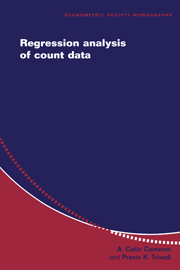Book contents
- Frontmatter
- Contents
- List of Figures
- List of Tables
- Preface
- 1 Introduction
- 2 Model Specification and Estimation
- 3 Basic Count Regression
- 4 Generalized Count Regression
- 5 Model Evaluation and Testing
- 6 Empirical Illustrations
- 7 Time Series Data
- 8 Multivariate Data
- 9 Longitudinal Data
- 10 Measurement Errors
- 11 Nonrandom Samples and Simultaneity
- 12 Flexible Methods for Counts
- Appendices
- References
- Author Index
- Subject Index
- Titles in the series
12 - Flexible Methods for Counts
Published online by Cambridge University Press: 05 January 2013
- Frontmatter
- Contents
- List of Figures
- List of Tables
- Preface
- 1 Introduction
- 2 Model Specification and Estimation
- 3 Basic Count Regression
- 4 Generalized Count Regression
- 5 Model Evaluation and Testing
- 6 Empirical Illustrations
- 7 Time Series Data
- 8 Multivariate Data
- 9 Longitudinal Data
- 10 Measurement Errors
- 11 Nonrandom Samples and Simultaneity
- 12 Flexible Methods for Counts
- Appendices
- References
- Author Index
- Subject Index
- Titles in the series
Summary
Introduction
In this chapter we examine methods for modeling count data that are more flexible than those presented in previous chapters. The focus is on the cross-section case, although some of the methods given here have potential extension to time series, multivariate or longitudinal count data, and treatment of sample selection.
One type of flexible modeling is to specify low-order conditional moments of the dependent variable, rather than the entire distribution. This moment-based approach has already been considered extensively in previous chapters. Here we extend it by considering higher-order moments. The emphasis is on the more difficult question of the most efficient use of the moments, with estimators derived using results on optimal GMM.
The core of the chapter considers two basic types of flexible model. First, we consider a sequence of progressively more flexible parametric models, where the underlying parameters in the sequence are tightly specified, for example, equal to a specified function of a linear combination of regressors and parameters.
Second, we consider models in which part of the distribution or general functional form for the moment is tightly specified, but the remainder is flexibly modeled. For example, the conditional mean may be the exponential of the sum of a linear combination of all but one regressor and a flexible function of the remaining regressor. A second example, in which the conditional mean function is specified but the conditional variance is flexible, has already been considered in earlier chapters but is covered in further depth here.
Information
- Type
- Chapter
- Information
- Regression Analysis of Count Data , pp. 344 - 370Publisher: Cambridge University PressPrint publication year: 1998
